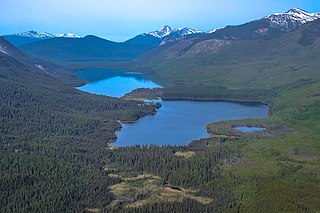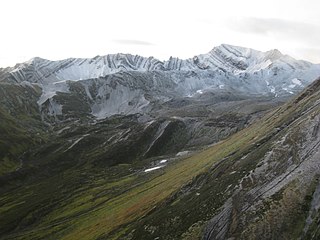
The Omineca Mountains, also known as "the Ominecas", are a group of remote mountain ranges in the Boreal Cordillera of north-central British Columbia, Canada. They are bounded by the Finlay River on the north, the Rocky Mountain Trench on the east, the Nation Lakes on the south, and the upper reaches of the Omineca River on the west. They form a section of the Continental Divide, that, in this region, separates water drainage between the Arctic and Pacific Oceans. The lower course of the Omineca River flows through the heart of the range. To the south of the Ominecas is the Nechako Plateau, to the west the Skeena Mountains and Hazelton Mountains, to the north the Spatsizi Plateau and the Stikine Ranges, while east across the Rocky Mountain Trench are the Muskwa Ranges.

The Skeena Mountains, also known as the Skeenas, are a subrange of the Interior Mountains of northern British Columbia, Canada, essentially flanking the upper basin of the Skeena River. They lie just inland from the southern end of the Boundary Ranges of the Coast Mountains, and also of the northern end of the Kitimat Ranges. Their southern limit is described by the Bulkley River and the upper northwestern reaches of Babine and Takla Lakes, and on their northeast by the upper reaches of the Omineca River.

The British Columbia Interior, popularly referred to as the BC Interior or simply the Interior, is a geographic region of the Canadian province of British Columbia. While the exact boundaries are variously defined, the British Columbia Interior is generally defined to include the 14 regional districts that do not have coastline along the Pacific Ocean or Salish Sea, and are not part of the Lower Mainland. Other boundaries may exclude parts of or even entire regional districts, or expand the definition to include the regional districts of Fraser Valley, Squamish–Lillooet, and Kitimat–Stikine.
The Thumb is a mountain located 7 km (4 mi) south of Sitchiada Mountain on the east side of Bear Lake, on the divide between the upper Omineca River and the basin of the Bear River in the Omineca Country of the Central-North Interior of British Columbia, Canada. As the Omineca is part of the Arctic Ocean drainage, via the Peace and Mackenzie Rivers, and the Bear is in the basin of the Skeena River, which drains to the Pacific, The Thumb is located on the Continental Divide.
The Swannell Ranges are a mountain range between the Finlay and Nation Rivers and between the Hogem Ranges and the Finlay Ranges of northern British Columbia, Canada. It has an area of 22932 km2 and is a subrange of the Omineca Mountains which in turn form part of the Interior Mountains. They are named in honour of legendary surveyor/explorer Frank Swannell.
The Metsantan Range are a mountain range between the upper Stikine and the Finlay River drainages in northern British Columbia, Canada. It has an area of 1116 km2 and is a subrange of the Omineca Mountains which in turn form part of the Interior Mountains.
The Tatlatui Range is a large and very alpine mountain range on the east flank of the upper Skeena River in northern British Columbia, Canada. It has an area of 2307 km2 and is a subrange of the Omineca Mountains which in turn form part of the Interior Mountains. The range features several lakes, the largest of which, Thutade Lake, is at the head of the Finlay River, and is considered the ultimate source of the Mackenzie River. Tatlatui Lake, the next largest lake in the range, to the northwest of Thutade Lake, is at the head of the Firesteel River, a tributary of the Finlay. Various summits of the range, which as described separates the Pacific and Arctic drainages, form part of the Continental Divide. Most of the range and its lakes are in Tatlatui Provincial Park.
The Axelgold Range is a subrange of the Hogem Ranges of the Omineca Mountains, located between Ominicetla Creek and upper Omineca River in northern British Columbia, Canada.
The Cariboo Heart Range is a subrange of the Hogem Ranges of the Omineca Mountains, located between Ominicetla Creek and Lion Creek in northern British Columbia, Canada.
The Connelly Range is a subrange of the Hogem Ranges of the Omineca Mountains, located between Bear Lake and the headwaters of the Omineca River in northern British Columbia, Canada. As the Omineca is in the Arctic Ocean drainage and Bear Lake that of the Pacific, the range is part of the Continental Divide. It includes a group of volcanic plugs, the largest of which is The Thumb.
The Mitchell Range is a subrange of the Hogem Ranges of the Omineca Mountains, bounded by Takla Lake and the Nation River in northern British Columbia, Canada.
The Sitlika Range is a subrange of the Hogem Ranges of the Omineca Mountains, bounded by both the Fall River and Ogden Creek in northern British Columbia, Canada.
The Vital Range is a subrange of the Hogem Ranges of the Omineca Mountains, bounded by Fall Creek, Silver Creek and Kenny Creek in northern British Columbia, Canada.
Tatlatui Lake is a lake in the Tatlatui Range of the Omineca Mountains of the Northern Interior of British Columbia, Canada. It is the source of the Firesteel River, the uppermost left tributary of the Finlay River, which begins just southeast at Thutade Lake, which is considered the ultimate source of the Mackenzie River. The lake and adjoining summits are part of Tatlatui Provincial Park.
The Sustut River is a major tributary of the Skeena River in the north-central Interior of British Columbia, Canada. It forms the northwest boundary of the Hogem Ranges and flows southwest to meet the Skeena, north of Hazelton. Originally named the Bear Wallow River, its headwaters are at Sustut Lake, northwest of Germansen Landing.
Sustut Lake is a lake in the Omineca Mountains of the Northern Interior of British Columbia, Canada, located northwest of Germansen Landing in the Cassiar Land District. It is the source of the Sustut River, which flows roughly west and is a major tributary of the Skeena River. The lake's old, or alternate, name is Bear Wallow Lake. Sustut Peak is located to the west of the lake.
Sustut Peak, 2,481 m (8,140 ft), prominence: 1,231 m (4,039 ft), is the highest summit in the drainage of the Sustut River in British Columbia, Canada. Located in the Hogem Ranges west of Sustut Lake, which is at the Sustut River's headwaters, it is 8 km (5 mi) southwest of the road to the Kemess Mine
Omineca Provincial Park and Protected Area is a provincial park and protected area located in the north-central interior of British Columbia, Canada. It was established on 11 April 2001 by BC Parks to protect provincially significant riparian and wetland habitats along the Omineca River.
The Mosque River is a tributary of the Skeena River in the Stikine Region of the province of British Columbia, Canada. It originates in the Tatlatui Range of the Skeena Mountains, and flows southwest about 50 km (31 mi) to the Skeena River, about 140 km (87 mi) north of Hazelton and about 160 km (99 mi) east of Stewart. Its watershed covers about 148 km2 (57 sq mi), and its mean annual discharge is 15.4 m3/s (540 cu ft/s).



